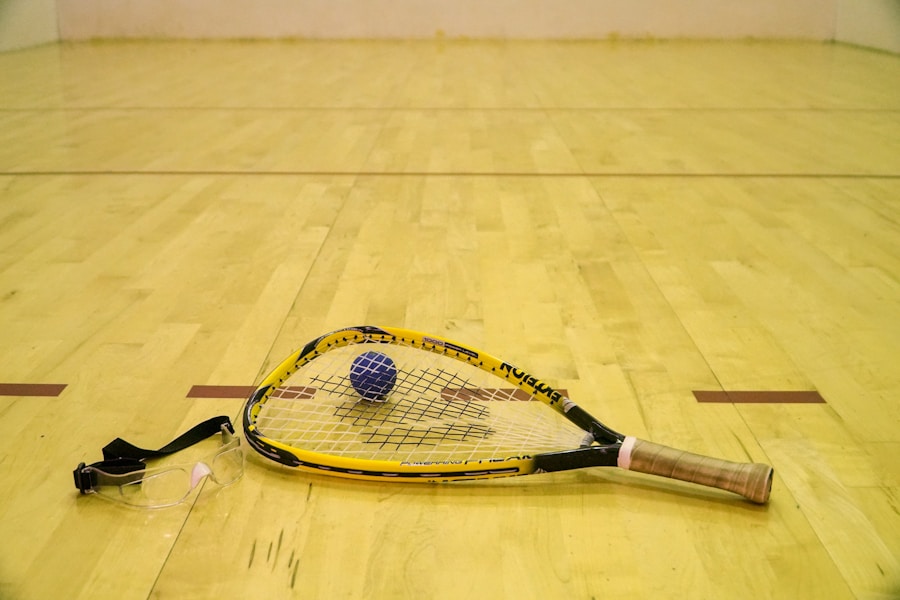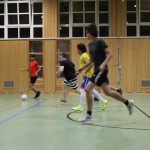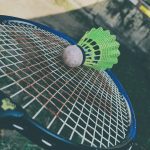Mastering the Art of Badminton: Tips for Success
Description
Badminton is a fast-paced racquet sport that has gained immense popularity worldwide, both as a competitive sport and a recreational activity. Originating in the mid-19th century, it has evolved into a game that requires not only physical prowess but also strategic thinking and mental acuity. The game is played either in singles or doubles format, with players using a shuttlecock, or birdie, which is hit back and forth over a net.
The objective is to score points by landing the shuttlecock in the opponent’s court while preventing them from doing the same. The scoring system has undergone changes over the years, with the current format being the rally scoring system, where points can be scored by either side regardless of who served. Understanding the court dimensions and layout is fundamental for any aspiring badminton player.
The court is rectangular, measuring 13.4 meters long and 6.1 meters wide for doubles play, while singles play narrows the width to 5.18 meters. The net stands at 1.55 meters high at the center, creating a barrier that players must skillfully navigate. Familiarity with the various zones of the court—such as the forecourt, midcourt, and backcourt—enables players to develop strategies for both offensive and defensive play.
Additionally, players must be aware of the rules governing service, faults, and scoring to ensure fair play and maintain the integrity of the game.
Key Takeaways
- Badminton is a fast-paced racket sport played with a shuttlecock, and requires agility, speed, and precision.
- Proper technique and footwork are essential for success in badminton, and players should focus on developing these skills from the beginning.
- Improving speed and agility through specific drills and exercises can give players a competitive edge on the court.
- Mastering different types of shots, such as the clear, drop shot, and smash, is crucial for a well-rounded game and keeping opponents off balance.
- Enhancing mental toughness and strategy is key to outsmarting opponents and staying focused during intense matches.
- Training and conditioning are vital for peak performance in badminton, and players should focus on strength, endurance, and flexibility to excel in the sport.
Developing Proper Technique and Footwork
Mastering badminton requires a solid foundation in technique and footwork, as these elements are crucial for executing shots effectively and maintaining balance during play. Proper grip on the racquet is essential; players typically use either the forehand or backhand grip depending on the shot being executed. The forehand grip allows for powerful smashes and clear shots, while the backhand grip is vital for returning shots from the opposite side of the body.
Players should practice transitioning between grips fluidly to adapt to various situations on the court. Footwork is equally important in badminton, as it dictates a player’s ability to reach the shuttlecock quickly and position themselves optimally for their next shot. Effective footwork involves a combination of quick steps, lunges, and pivots that allow players to cover the court efficiently.
A common technique is the “split step,” where players momentarily jump or shift their weight to prepare for their opponent’s shot. This technique not only enhances reaction time but also helps maintain balance when moving in different directions. Practicing footwork drills, such as ladder drills or shadow badminton, can significantly improve agility and coordination on the court.
Improving Speed and Agility

Speed and agility are paramount in badminton, where rallies can change direction in an instant. Players must develop explosive speed to reach the shuttlecock before their opponents do. Sprinting drills can be incorporated into training regimens to enhance overall speed.
Short sprints of 10 to 20 meters can simulate the quick bursts of movement required during a match. Additionally, interval training can be beneficial; alternating between high-intensity sprints and periods of rest helps build endurance while mimicking the stop-and-go nature of badminton. Agility training focuses on improving a player’s ability to change direction quickly while maintaining control.
Cone drills are an effective way to enhance agility; setting up cones in various patterns allows players to practice quick lateral movements and sharp turns. Plyometric exercises, such as box jumps or lateral hops, can also contribute to improved agility by developing fast-twitch muscle fibers essential for rapid movements on the court. Incorporating these drills into regular training sessions will not only enhance speed but also improve overall athletic performance.
Mastering Different Types of Shots
| Shot Type | Success Rate (%) | Difficulty Level |
|---|---|---|
| Forehand Drive | 85 | Intermediate |
| Backhand Slice | 70 | Advanced |
| Volley | 90 | Beginner |
| Serve | 95 | Advanced |
A well-rounded badminton player must be proficient in executing various types of shots, each serving a specific purpose during a match. The fundamental shots include clears, drops, smashes, and drives, each requiring distinct techniques and timing. The clear shot is typically used to send the shuttlecock high and deep into the opponent’s court, allowing players time to reposition themselves.
It can be executed from both forehand and backhand positions and is often used defensively to regain control of the rally. The drop shot, on the other hand, is a delicate maneuver aimed at placing the shuttlecock just over the net, forcing opponents to rush forward. This shot requires precise timing and touch; players must practice their wrist action to achieve the desired effect.
Smashes are powerful downward shots that aim to finish rallies quickly; mastering this shot involves generating significant racket head speed and utilizing body weight effectively. Drives are fast-paced shots that travel horizontally over the net, often used in fast exchanges during doubles play. Each shot requires dedicated practice to master its nuances and incorporate them seamlessly into gameplay.
Enhancing Mental Toughness and Strategy
Mental toughness is an often-overlooked aspect of badminton that can significantly influence performance during matches. Players must cultivate resilience to handle pressure situations, maintain focus, and recover from setbacks during gameplay. Visualization techniques can be beneficial; imagining successful shots or positive outcomes can help build confidence before stepping onto the court.
Additionally, mindfulness practices such as meditation can enhance concentration and reduce anxiety levels during competitive play. Strategic thinking is equally important in badminton; players must analyze their opponents’ strengths and weaknesses while adapting their own gameplay accordingly.
For instance, if an opponent struggles with high shots, a player might focus on executing more clears or smashes to exploit this weakness. Furthermore, understanding when to switch tactics—such as transitioning from aggressive play to defensive strategies—can be crucial in gaining an advantage during tight matches.
Training and Conditioning for Peak Performance

To achieve peak performance in badminton, players must engage in comprehensive training and conditioning programs that address all aspects of physical fitness. Strength training is vital for building muscle endurance and power; exercises targeting major muscle groups—such as squats for leg strength or core exercises like planks—can enhance overall athleticism on the court. Resistance training with bands or weights can also improve shot power and stability during play.
In addition to strength training, cardiovascular conditioning plays a critical role in sustaining energy levels throughout matches.
Flexibility training should not be neglected; incorporating stretching routines can enhance range of motion and reduce the risk of injuries associated with sudden movements on the court.
Nutrition also plays a pivotal role in an athlete’s performance; maintaining a balanced diet rich in carbohydrates, proteins, and healthy fats ensures that players have adequate energy reserves for training and competition. Hydration is equally important; staying well-hydrated helps maintain focus and physical performance during matches. By combining these elements—strength training, cardiovascular conditioning, flexibility exercises, and proper nutrition—players can optimize their training regimens for peak performance in badminton competitions.
In summary, badminton is a multifaceted sport that demands a blend of physical skill, mental acuity, and strategic thinking. By understanding its fundamentals, developing proper techniques, improving speed and agility, mastering various shots, enhancing mental toughness, and committing to rigorous training regimens, players can elevate their game to new heights. Each aspect contributes uniquely to overall performance, making it essential for aspiring athletes to approach their training holistically for success on the court.
If you’re looking to maximize your game in badminton, you should check out the article “Maximizing Your Game with Taya777 Online Sports”. This article provides tips and strategies for improving your skills and performance on the court. Whether you’re a beginner or a seasoned player, you’ll find valuable insights to help take your game to the next level. So lace up your shoes, grab your racket, and get ready to dominate the competition with the help of Taya777 Online Sports.
FAQs
What is badminton?
Badminton is a racquet sport played by either two opposing players (singles) or two opposing pairs (doubles), who take positions on opposite halves of a rectangular court divided by a net.
What equipment is used in badminton?
The primary equipment used in badminton includes a shuttlecock (also known as a birdie), badminton racquets, and a net. Players also wear appropriate footwear for the sport.
What are the basic rules of badminton?
The basic rules of badminton include serving diagonally, scoring points by landing the shuttlecock within the opponent’s court, and winning a match by winning two out of three games.
What are the health benefits of playing badminton?
Playing badminton can provide various health benefits, including improved cardiovascular fitness, agility, flexibility, and hand-eye coordination. It also helps in burning calories and improving overall physical fitness.
What are the different types of badminton shots?
Some of the different types of badminton shots include the clear, drop shot, smash, drive, and the backhand shot. Each shot has its own specific technique and purpose during a game.
What are the major badminton tournaments and events?
Some of the major badminton tournaments and events include the All England Open Badminton Championships, BWF World Championships, Thomas Cup (men’s team event), Uber Cup (women’s team event), and the Olympic Games.





